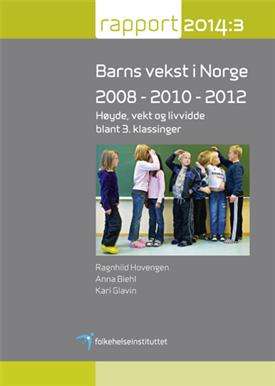Childhood obesity unevenly distributed in Norway

Overweight, obesity and abdominal obesity are distributed unevenly among children in Norway. Maternal education level, parental marital status and whether the child lives in urban or rural areas all play a role. These findings come from a new report from the Child Growth Study at the Norwegian Institute of Public Health.
Overweight and obesity in childhood can have serious consequences for children's health and is a risk factor for morbidity in adulthood. There is concern that the development of overweight and obesity among children may contribute to continued social inequalities in health in the future.
From 2008 to 2012 there was no increase in the average prevalence in overweight, obesity or abdominal obesity (waist circumference) among Norwegian third graders. However, the results show socioeconomic and geographical divides in overweight and obesity development among children.
Socioeconomic, demographic and geographic differences
- There was a significant difference in overweight (including obesity) between the health regions. In the south east, the proportion was significantly lower and in the northern health region the proportion was significantly higher than in the other regions.
- The prevalence of overweight and obesity was 1.5 to 2 times higher among third graders from small municipalities compared with students in large municipalities. The difference in the prevalence of abdominal obesity between small and large municipalities was even greater than for overweight and obesity.
- The prevalence of overweight and obesity was 30 per cent higher, and abdominal obesity was 80 per cent higher, among children of mothers with a lower education compared with children of highly educated mothers.
There was a 50 per cent larger proportion of children with overweight and obesity, and nearly twice as many children with abdominal obesity, among third graders with divorced parents compared with children with married parents.
No increase in the average prevalence of obesity
On average, there was no increase in overweight, obesity and abdominal obesity among third graders in Norway from 2008 until 2012 which indicates that the prevalence appears to have stabilised during this period.
- Every sixth pupil (16 per cent) was overweight or obese in the period 2008-2012 and during the same period an average of eight per cent of pupils had abdominal obesity.
- The girls had a higher prevalence of overweight and obesity than boys, with 17.9 per cent and 14.5 per cent respectively. There were small gender differences in the proportion with abdominal obesity.
- In the analysis of height and weight from birth, the researchers saw that students who were overweight or obese in third grade had a significantly faster growth already in the first year of life compared with the third graders who were not obese at eight years of age.
- On average, 55 per cent of pupils walked or cycled to school and every third pupil arrived by car.
Concerned about increased social inequalities in health
"It is positive that the proportion of overweight third graders did not seem to increase in the period from 2008 to 2012, for either girls or boys. However, it is worrying that there is a significant proportion of children with overweight, obesity and abdominal obesity related to their families' socioeconomic status, parents' marital status and whether they live in small or large municipalities (urban / rural). There is a danger that trends in overweight and obesity in some groups will help to maintain and increase social inequalities in the years to come," says Ragnhild Hovengen, Project Manager for the Child Growth Study.
Health clinics and school health services have key roles
Hovengen believes that public health programmes in kindergartens, in school and in the community should be aimed at eating habits and physical activity to prevent obesity among children, with an aim of reducing social inequalities in health from early childhood.
"Health clinics and school health services have a unique opportunity to identify children and families at risk of developing obesity and other health problems and they must be encouraged to introduce preventive activities among children and young people in their municipalities," says Hovengen.
About the Child Growth Study
The Child Growth Study was conducted in 2012 for the third time among a national sample of third graders, with a participation rate of 90 per cent among the pupils. The study is a collaboration between the school health service at the selected schools and the Norwegian Directorate of Health. The next study will be conducted in the third grade at the same schools in autumn 2015. This is the only national study in Norway that follows development of overweight and obesity in the same age group over time.
General overweight and obesity, based on BMI (body mass index), and abdominal obesity are measured in this study. Abdominal obesity is calculated by dividing the waist circumference by the child's height – figures higher than 0.5 are classified as abdominal obesity.

















